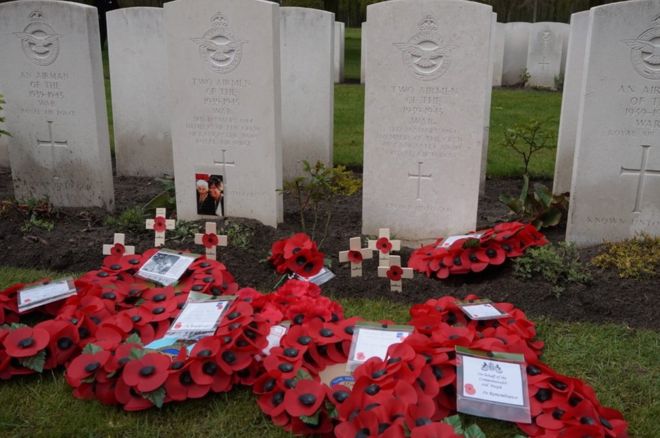The remains of 10 previously unidentified RAF airmen were recently identified and a re-dedication service held for them at the Commonwealth War Graves Commission’s Berlin 1939–1945 cemetery on April 27. Given that there were a large number of casualties in the war many service personnel have never been identified. The military has never forgotten about them and even 70 years after the events there is still a determination to ensure that the unidentified dead are found and given a proper burial.
New headstones were carved with the names of the crews of the Lancaster and Halifax bomber that crashed during bombing raids over Germany in January 1944. The Lancaster JB640 took off for Berlin on January 2, 1944, with seven crewmen on board, after which it went MIA. No other details of its final hours are known. It was assumed that it was shot down and had crashed with all the crew onboard and that there were no survivors. This was the fate of many bombers during the period from 1940-1945.
The Halifax LK709 also had a seven-man crew. This aircraft also went MIA when on a mission over Germany during the height of the war. It crashed in a lake on January 28, 1944. Four members of the crew already had names on their headstones. At the time, it was impossible to recover the plane or the crew.
Tens of thousands of men died in the bombing campaign, over Germany. Those who participated in the bombing of Germany played a crucial role in the world and suffered from a very high casualty rate. German fighters and anti-aircraft fire took a tremendous toll on RAF bombers and their crews.

Members of the airmen’s families attended the service in Germany. The British Ministry of Defence had called for relatives to come forward earlier in April. After a period of time, several members of the men’s families came forward. It is hoped that the received comfort from the fact that the men had at long last been identified and given a decent burial. Many of the men’s family members died without ever finding out how the men died and where was their final resting place.
The ceremonies were arranged by the MoD’s Joint Casualty and Compassion Centre, headquartered at Imjin Barracks, Gloucester. This body seeks to provide a decent burial for all those who gave their life for their country and tries to support their grieving relatives.
The airmen on Lancaster JB640
- Pilot Officer John Donald Range Cromarty (aged 23) – from Liverpool.
- Flt Sgt Dennis Frederick Burtenshaw (20) – from Sydney, Australia. Later lived in south London.
- Flt Sgt Leonard Norman Lapthorne (21) – from Birmingham.
- Flt Sgt Reginald Joseph Collens (31) – from Croydon, south London.
- Flt Sgt Kenneth Sidney James Chapman (20) – from Westbury, Wiltshire.
- Sgt Frederick Edwin Woolven (23) – from Arundel, Sussex.
- Sgt Norman Henry Colebatch (20) – from Walsall.
The airmen on Halifax LK709
- Pilot Officer William Proffitt White (23) – from Shotteswell, Warwickshire.
- Flt Sgt Norman Thompson Steele (21) – from Ashington, Northumberland.
- Flt Sgt Arthur Binnie Walker (21) – from Glasgow.
- Sgt Thomas Ernest Edwards (22) – from Durham.
- Sgt Leslie Raymond Bright (22) – from London.
- Sgt Kenneth Bray (21) – from Grimsby.
- Sgt David Winston Jenkins (22) – from Swansea.
Berlin South-Western Cemetery
In 1922-23 it was decided that the graves of Commonwealth servicemen who had died in the First World War all over Germany should be brought together into four permanent cemeteries. Berlin South-Western was one of those chosen and in 1924-25, graves were brought into the cemetery from 146 burial grounds in eastern Germany.
There are now 1,176 First World War servicemen buried or commemorated in the Commonwealth plot at Berlin South-Western Cemetery. The total includes special memorials to a number of casualties buried in other cemeteries in Germany whose graves could not be found.
